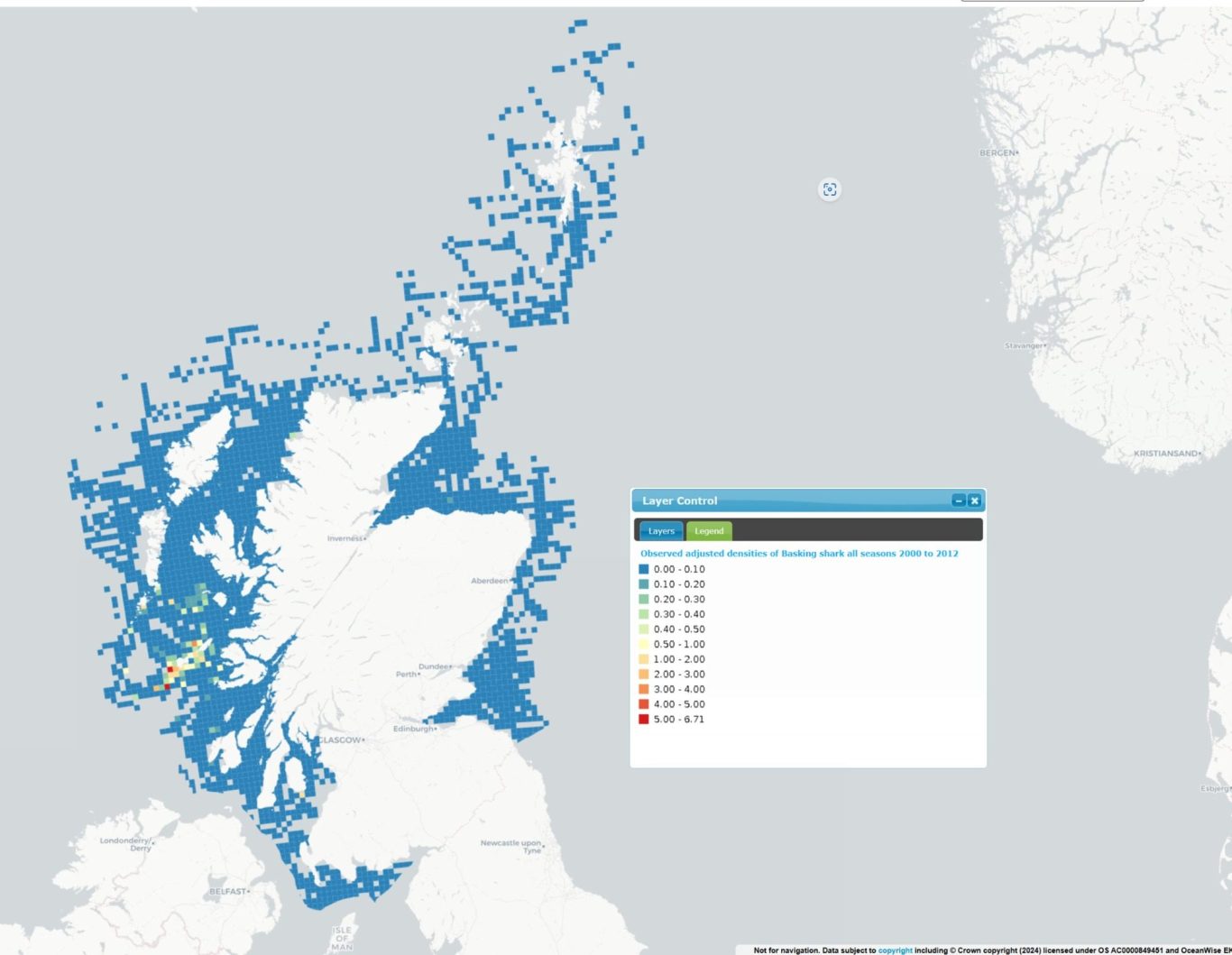Basking Sharks (Cetorhinus maxius)
Key Findings
Of the 30+ shark, skate and ray species present in Scotland (Scottish Government, 2011), basking sharks (fig. 1) are the largest of the lot, growing to an average of 7.9m long (OSPAR Commission, 2021). They appear in Scotland during the summertime, migrating while waters are warmer and food is more abundant. They have been a protected species since 1998 in Scotland, and are listed as endangered worldwide (NatureScot, 2023).
Niche:
Basking sharks are filter feeders, catching plankton by gulping up to 2000 tons of water per hour (National Geographic, 2021). As such, they tend to live near the ocean surface, although have been observed moving over the seabed (NatureScot, 2023).
Fishing:
While no longer targeted for fishing in the UK (OSPAR Commission, 2021), decades of being hunted for their liver oil have reduced basking shark numbers by between ½ - 4/5ths (Scottish Government, 2011). In some parts of the world, they are still subject to fishing, often for shark fin soup production. (Basking Shark Scotland, n.d.).
Distribution:
Basking sharks are widespread around the globe (fig. 2) (OSPAR Assessment Portal, 2021). They tend to live in shallower areas of the ocean, like continental shelves or shelves around islands (insular shelves) (OSPAR Assessment Portal, 2021). These shallow areas are where their prey - zooplankton - are found. Zooplankton occur where waters are rich in nutrients. In shallow waters, wind driven waves bring nutrients to the surface, allowing phytoplankton (primary producers) to bloom, which zooplankton feed on, which in turn attracts the basking sharks. In Scotland, basking sharks are known to be most concentrated around the West Coast and the Sea of the Hebrides. On the East of Scotland, basking sharks are common along the Moray Coast, with another small cluster around Eyemouth (figs. 3-6). This is likely the result of favourable habitat location distribution, rather than differences in the effectiveness of monitoring (Elasmobranchs Draft Document).
Breeding:
The basking shark breeding process remains mysterious. They are known to be ovoviviparous, being born live after developing within an egg (Basking Shark Scotland, n.d.). As with many other shark, ray and skate species, the reproductive process takes a long time: 20 years for females to reach sexual maturity, and a 3.5-year gestation period (National Geographic, 2021). This makes population recovery an especially slow process. Only one birth has been witnessed, and mating is yet to be observed. (National Geographic, 2021)
Threats in Scottish Waters:
Entanglement and Bycatch: As a surface water dwelling species, they are at especially high risk of becoming caught up in fishing activities. Entanglement appears to be highly deadly for basking sharks, with 80% of the 49 entanglements recorded in 2018-2019 resulting in the death of the shark (MacLennan et al, 2021). They are also at risk of collision with vessels on the water surface, being injured by sturdy bows or sharp propellors (Elasmobranch Draft Document).
Habitat Alteration/Degradation: As climate change continues to warm waters around the globe, the habitat range for basking sharks may shift to compensate. Other anthropogenic impacts, such as litter, chemical and microplastic pollution of the oceans also pose a large threat. Being at the highest end of the food chain, basking sharks are at risk of bioaccumulation, wherein contaminants enter the food chain at lower levels, and become more concentrated as they pass upwards. (Elasmobranchs Draft Document).
Abundance in Scottish Waters:
Being so difficult to observe, combined with their migratory behaviours, the OSPAR Assessment Portal lists their population status as ‘unknown’, although population levels do not appear to have changed from previous years (OSPAR Assessment Portal, 2021).

ianhaywildlife@outlook.com

Observed adjusted densities of Basking Sharks all seasons 2002-2012
Notes
Linked Information Sheets
Key sources of Information
Reviewed on/by
Status
Published
To report errors, highlight new data, or discuss alternative interpretations, please complete the form below and we will aim to respond to you within 28 days
Contact us
Telephone: 07971149117
E-mail: ian.hay@stateofthecoast.scot
We need your consent to load the translations
We use a third-party service to translate the website content that may collect data about your activity. Please review the details in the privacy policy and accept the service to view the translations.

